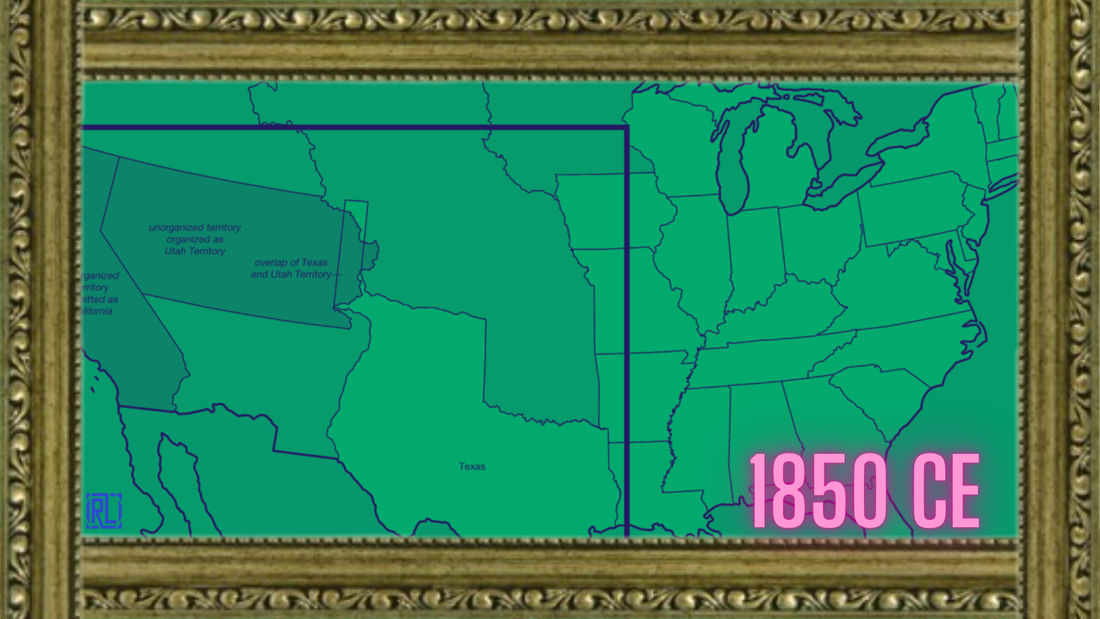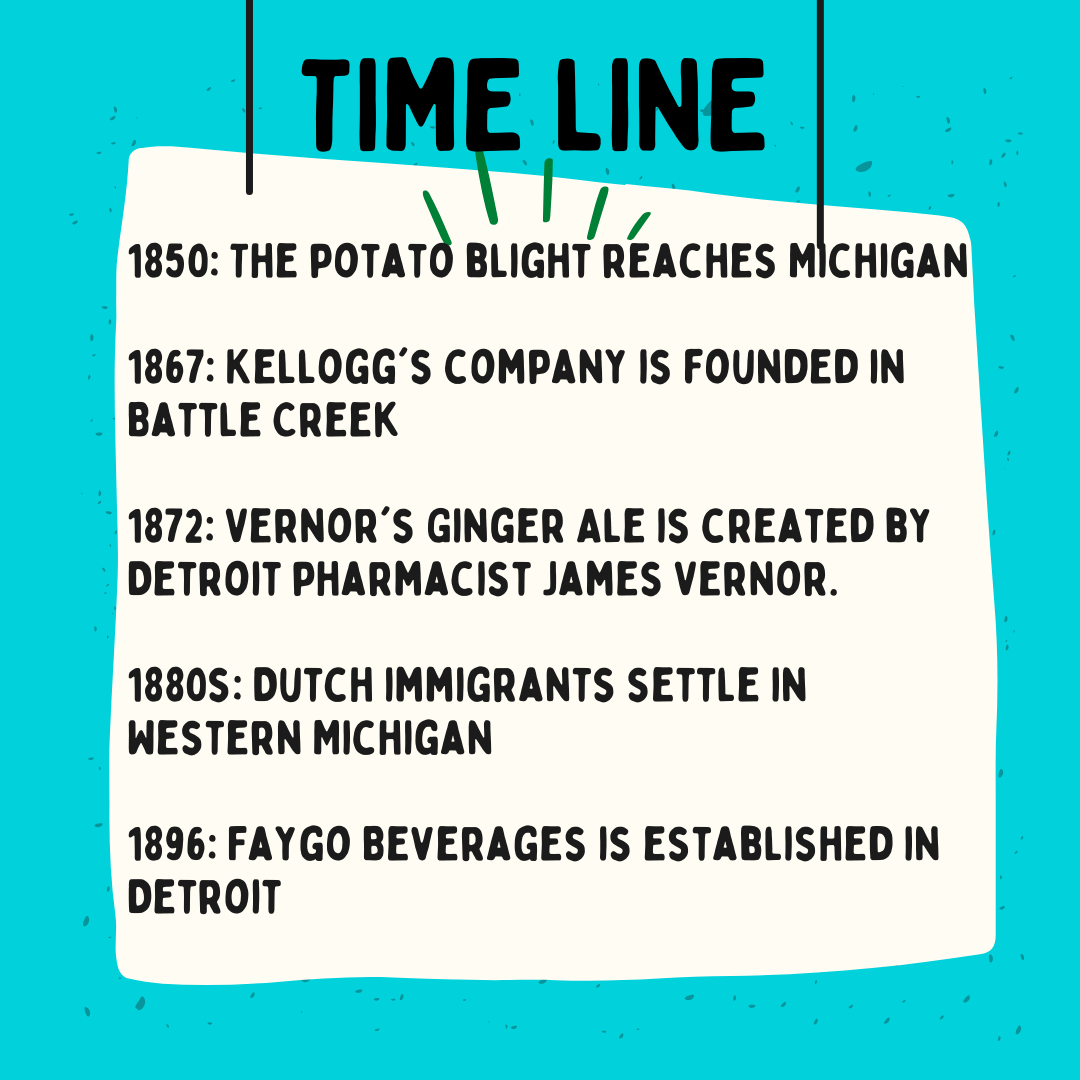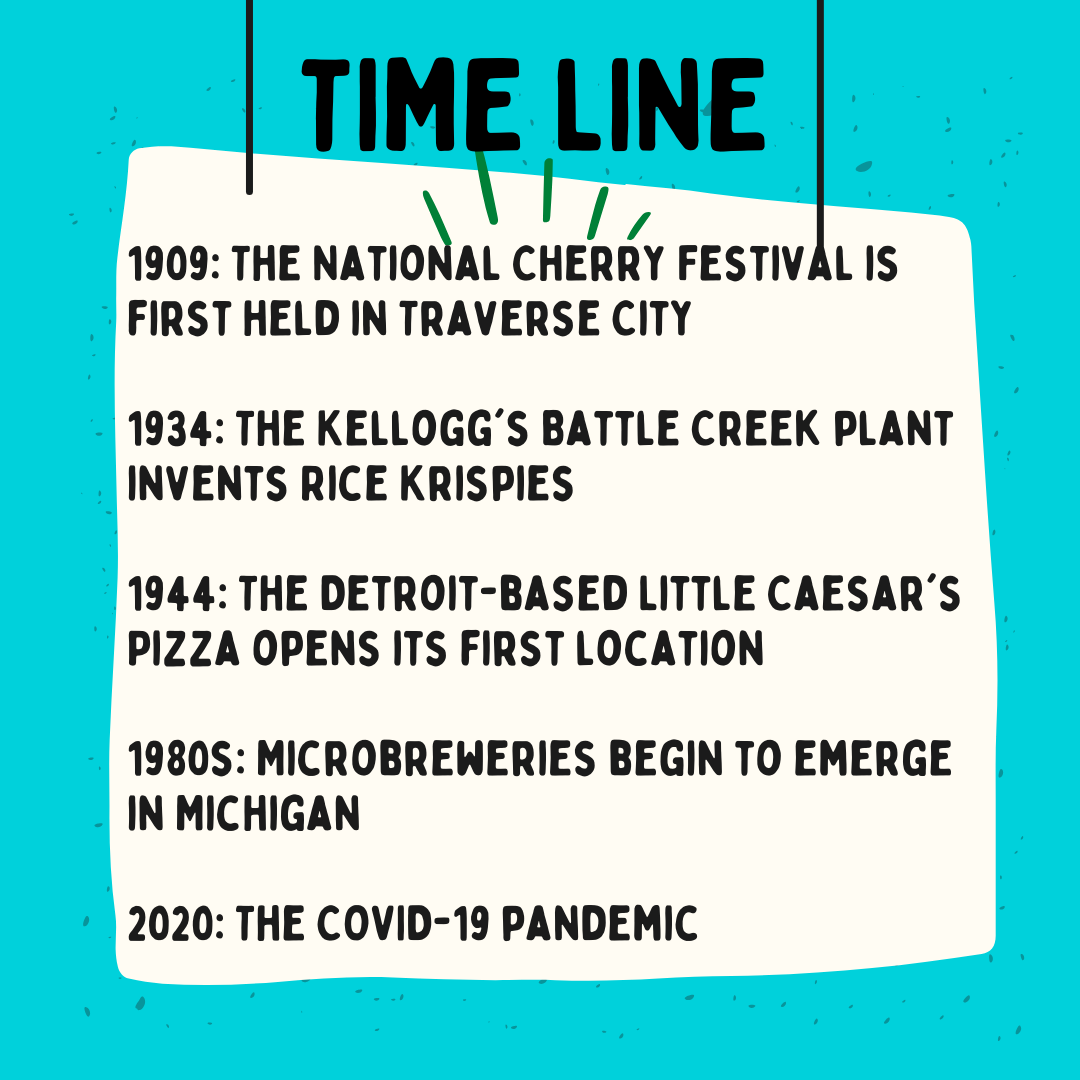Module Six: Blue Lakes & Blue Plates
Alright, hold onto your hats, my fellow food enthusiasts and history buffs, because we're about to take a deep dive into the culinary adventures of Michigan – a journey that'll tantalize your taste buds and ignite your passion for the past. Imagine Michigan, with its lakes, automobiles, and ongoing debate about whether it resembles a mitten or a hand, giving a high five to Wisconsin. But today, we're setting aside discussions about cars and geography to explore the fascinating world of Michigan's food heritage.
Let's rewind to when Michigan was inhabited by Native American tribes, long before modern distractions like backyard barbecues. These indigenous peoples had a profound connection with the land, mastering its bounty while indulging in culinary creativity. Then came the Europeans, bringing new ingredients, cooking methods, and spices, igniting a fusion of flavors that transformed Michigan's food scene into a cultural melting pot. As time marched on, Michigan's agricultural prowess became increasingly evident. From cherries to apples to blueberries, the state became a haven for fresh produce, with Traverse City proudly declaring itself the "Cherry Capital of the World." However, the Industrial Revolution disrupted this idyllic picture, ushering in an era of mass production and fast food frenzy, particularly in cities like Detroit.
Yet, amidst the chaos, immigrants breathed new life into Michigan's culinary landscape. Polish, Italian, Middle Eastern – each group contributed its unique flavors, enriching the gastronomic tapestry of the state. Greektown in Detroit is a testament to this cultural exchange, a vibrant hub of diverse cuisines. However, let's not romanticize the past entirely. The Industrial Revolution distanced us from the origins of our food, leading to a reliance on processed meals and environmental degradation. Yet, there's hope in acknowledging our mistakes and striving for a more sustainable future.
By exploring Michigan's culinary history, we gain insight into our collective identity and pave the way for a more conscientious approach to food. So, here's to Michigan – a beacon of culinary diversity and resilience. May we honor its past, savor its flavors, and chart a course toward a more flavorful and sustainable future. Cheers to embracing the richness of history and the promise of culinary innovation.
THE RUNDOWN
QUESTIONS
Let's rewind to when Michigan was inhabited by Native American tribes, long before modern distractions like backyard barbecues. These indigenous peoples had a profound connection with the land, mastering its bounty while indulging in culinary creativity. Then came the Europeans, bringing new ingredients, cooking methods, and spices, igniting a fusion of flavors that transformed Michigan's food scene into a cultural melting pot. As time marched on, Michigan's agricultural prowess became increasingly evident. From cherries to apples to blueberries, the state became a haven for fresh produce, with Traverse City proudly declaring itself the "Cherry Capital of the World." However, the Industrial Revolution disrupted this idyllic picture, ushering in an era of mass production and fast food frenzy, particularly in cities like Detroit.
Yet, amidst the chaos, immigrants breathed new life into Michigan's culinary landscape. Polish, Italian, Middle Eastern – each group contributed its unique flavors, enriching the gastronomic tapestry of the state. Greektown in Detroit is a testament to this cultural exchange, a vibrant hub of diverse cuisines. However, let's not romanticize the past entirely. The Industrial Revolution distanced us from the origins of our food, leading to a reliance on processed meals and environmental degradation. Yet, there's hope in acknowledging our mistakes and striving for a more sustainable future.
By exploring Michigan's culinary history, we gain insight into our collective identity and pave the way for a more conscientious approach to food. So, here's to Michigan – a beacon of culinary diversity and resilience. May we honor its past, savor its flavors, and chart a course toward a more flavorful and sustainable future. Cheers to embracing the richness of history and the promise of culinary innovation.
THE RUNDOWN
- Michigan's food history reflects its diverse cultural influences, economic shifts, and agricultural innovations.
- Indigenous peoples, like Native American tribes, played a crucial role in Michigan's culinary journey by cultivating a deep connection with the land.
- European settlers in the 17th century brought new ingredients and cooking techniques, blending indigenous staples with European flavors.
- Michigan's fertile soil and favorable climate made it a prime location for agriculture, with a focus on cherries, apples, and blueberries.
- The industrial revolution in the 19th and 20th centuries led to factory farming, mass production, and the rise of fast-food culture in urban areas.
- Diverse immigrant communities, including Polish, Italian, Middle Eastern, and others, contributed unique flavors and cooking traditions to Michigan's culinary mosaic.
- Studying Michigan's food history provides insights into the state's development, the interconnectedness of communities, and the impact of global and local events on daily life.
- The positives and negatives of historical events in Michigan's food history offer valuable lessons for present and future challenges related to food sustainability, health, and cultural preservation.
QUESTIONS
- Traverse City is known as the "Cherry Capital of the World." What factors contributed to the prominence of cherries in Michigan's agricultural industry, and how have they shaped the state's cuisine?
- The Industrial Revolution brought about significant changes in food production and consumption patterns. How did this era affect the availability and quality of food in Michigan, particularly in urban centers like Detroit?
- Discuss the role of immigrants in shaping Michigan's culinary landscape. What cultural influences did groups like the Polish, Italian, and Middle Eastern communities bring to the state, and how are these influences reflected in modern Michigan cuisine?
#6 No Cherry Picking
The delicate dance of selective memory, where the past is plucked like ripe fruit, should be ready for consumption or transformation. But let's be honest – history, akin to a bruised cherry, can leave a bitter aftertaste if not cautiously approached. Picture a world where history is presented buffet-style, with patrons selecting the choicest bits to suit their palate. The Civil Rights Movement, a rich tapestry of defiance and perseverance, illustrates the power of selective memory. We highlight figures like Martin Luther King Jr. and Rosa Parks, lauding them as heroes while overlooking the countless others who fought in obscurity, their names fading into history.
And what of the American Revolution, that grand saga of rebellion and rhetoric? We pluck freedom and independence from the annals, showcasing them while conveniently ignoring the darker shades of slavery and displacement. Selective memory is a perilous path. It's akin to constructing a sturdy edifice with only the shiniest bricks – appealing on the surface, yet destined to crumble under scrutiny.
Learn from the cautionary tales of history's past manipulators. Recall how the Nazis twisted Germany's past into a narrative of racial purity? Or how the Soviets painted the Russian Revolution in heroic hues while erasing Stalin's atrocities? So, how do we navigate this minefield of memory? How do we steer clear of bias and distortion?
The answer lies in equilibrium. We must approach history like a connoisseur comes fine wine – with discernment, curiosity, and skepticism. We must consult diverse sources from various perspectives and allow ourselves to be challenged and enlightened. Ultimately, history is not a rigid menu but a vast feast where every dish – regardless of flavor – deserves recognition.
RUNDOWN
STATE OF THE STATE
And what of the American Revolution, that grand saga of rebellion and rhetoric? We pluck freedom and independence from the annals, showcasing them while conveniently ignoring the darker shades of slavery and displacement. Selective memory is a perilous path. It's akin to constructing a sturdy edifice with only the shiniest bricks – appealing on the surface, yet destined to crumble under scrutiny.
Learn from the cautionary tales of history's past manipulators. Recall how the Nazis twisted Germany's past into a narrative of racial purity? Or how the Soviets painted the Russian Revolution in heroic hues while erasing Stalin's atrocities? So, how do we navigate this minefield of memory? How do we steer clear of bias and distortion?
The answer lies in equilibrium. We must approach history like a connoisseur comes fine wine – with discernment, curiosity, and skepticism. We must consult diverse sources from various perspectives and allow ourselves to be challenged and enlightened. Ultimately, history is not a rigid menu but a vast feast where every dish – regardless of flavor – deserves recognition.
RUNDOWN
- Cherry-picking in history emphasizes selected positives while ignoring broader contexts.
- It can highlight important issues but may oversimplify complex events.
- Examples include focusing on Martin Luther King Jr. while neglecting other key figures in the Civil Rights Movement.
- Selective history can justify present oppression, such as using the American Revolution to support imperialism.
- Resisting cherry-picking and embracing diverse perspectives is crucial for a comprehensive understanding.
- Learning from the pitfalls of cherry-picking aids in appreciating history more accurately.
STATE OF THE STATE
HIGHLIGHTS
We've got some fine classroom lectures coming your way, all courtesy of the RPTM podcast. These lectures will take you on a wild ride through history, exploring everything from ancient civilizations and epic battles to scientific breakthroughs and artistic revolutions. The podcast will guide you through each lecture with its no-nonsense, straight-talking style, using various sources to give you the lowdown on each topic. You won't find any fancy-pants jargon or convoluted theories here, just plain and straightforward explanations anyone can understand. So sit back and prepare to soak up some knowledge.
LECTURES
LECTURES
- UNDER CONSTRUCTION!
READING
This class utilizes the following textbook:
Hathaway, Richard J. Michigan Visions of Our Past. United States Of America: Michigan State University Press, 1989.
"Michigan: Visions of Our Past" is an exhilarating adventure through the state's eventful history, led by scholars like Hathaway wielding the tools of the past. This collection reads like a diverse assortment of exciting stories and surprising revelations, providing a non-linear exploration of Michigan's struggle with its identity – be it navigating labor disputes, economic ups and downs, or the enduring conflict between religion and education. The book, resembling more of a mind-bending trip than a traditional history lesson, reflects Michigan's tumultuous history, encouraging readers to recognize that history is not merely a forgotten tome but a guidebook for the state's uncertain future. In this unconventional narrative, Michigan's history unfolds as a disorderly, absurd spectacle – a turbulent, unpredictable journey that embraces idiosyncrasies, confronts challenges, and invites everyone to the lively celebration of the past.
- Hathaway Chapter One: "Land and People of Freshwater: The Geography of Michigan"
This class utilizes the following textbook:
Hathaway, Richard J. Michigan Visions of Our Past. United States Of America: Michigan State University Press, 1989.
"Michigan: Visions of Our Past" is an exhilarating adventure through the state's eventful history, led by scholars like Hathaway wielding the tools of the past. This collection reads like a diverse assortment of exciting stories and surprising revelations, providing a non-linear exploration of Michigan's struggle with its identity – be it navigating labor disputes, economic ups and downs, or the enduring conflict between religion and education. The book, resembling more of a mind-bending trip than a traditional history lesson, reflects Michigan's tumultuous history, encouraging readers to recognize that history is not merely a forgotten tome but a guidebook for the state's uncertain future. In this unconventional narrative, Michigan's history unfolds as a disorderly, absurd spectacle – a turbulent, unpredictable journey that embraces idiosyncrasies, confronts challenges, and invites everyone to the lively celebration of the past.
Howard Zinn was a historian, writer, and political activist known for his critical analysis of American history. He is particularly well-known for his counter-narrative to traditional American history accounts and highlights marginalized groups' experiences and perspectives. Zinn's work is often associated with social history and is known for his Marxist and socialist views. Larry Schweikart is also a historian, but his work and perspective are often considered more conservative. Schweikart's work is often associated with military history, and he is known for his support of free-market economics and limited government. Overall, Zinn and Schweikart have different perspectives on various historical issues and events and may interpret historical events and phenomena differently. Occasionally, we will also look at Thaddeus Russell, a historian, author, and academic. Russell has written extensively on the history of social and cultural change, and his work focuses on how marginalized and oppressed groups have challenged and transformed mainstream culture. Russell is known for his unconventional and controversial ideas, and his work has been praised for its originality and provocative nature.
My classes utilize both Howard Zinn's A People's History of the United States and Larry Schweikart's Patriot's History of the United States, mostly in excerpts posted to the modules.
My classes utilize both Howard Zinn's A People's History of the United States and Larry Schweikart's Patriot's History of the United States, mostly in excerpts posted to the modules.

Zinn, A People's History of the United States
...Between the Civil War and 1900, steam and electricity replaced human muscle, iron replaced wood, and steel replaced iron (before the Bessemer process, iron was hardened into steel at the rate of 3 to 5 tons a day; now the same amount could be processed in 15 minutes).
Machines could now drive steel tools. Oil could lubricate machines and light homes, streets, factories. People and goods could move by railroad, propelled by steam along steel rails; by 1900 there were 193,000 miles of railroad. The telephone, the typewriter, and the adding
machine speeded up the work of business.
Machines changed farming. Before the Civil War it took 61 hours of labor to produce an acre of wheat. By 1900, it took 3 hours, 19 minutes. Manufactured ice enabled the transport of food over long distances, and the industry of meatpacking was born."
...Between the Civil War and 1900, steam and electricity replaced human muscle, iron replaced wood, and steel replaced iron (before the Bessemer process, iron was hardened into steel at the rate of 3 to 5 tons a day; now the same amount could be processed in 15 minutes).
Machines could now drive steel tools. Oil could lubricate machines and light homes, streets, factories. People and goods could move by railroad, propelled by steam along steel rails; by 1900 there were 193,000 miles of railroad. The telephone, the typewriter, and the adding
machine speeded up the work of business.
Machines changed farming. Before the Civil War it took 61 hours of labor to produce an acre of wheat. By 1900, it took 3 hours, 19 minutes. Manufactured ice enabled the transport of food over long distances, and the industry of meatpacking was born."

Larry Schweikart, A Patriot's History of the United States
"...By the mid-1700s, it was clear across the American colonies that the settlers had become increasingly less English. Travelers described Americans as coarse-looking country folk. Most colonials wore their hair long. Women and girls kept their hair covered with hats, hoods, and
kerchiefs while men and boys tied their hair into queues until wigs came into vogue in the port cities. Colonials made their own clothes from linen (flax) and wool; every home had a spinning wheel and a loom, and women sewed and knitted constantly, since cotton cloth would not be readily available until the nineteenth century. Plentiful dyes like indigo, birch bark, and pokeberries made colorful shirts, pants, dresses, socks, and caps.
Americans grew their own food and ate a great deal of corn—roasted, boiled, and cooked into cornmeal bread and pancakes. Hearty vegetables like squash and beans joined apples, jam, and syrup on the dinner table. Men and boys hunted and fished; rabbit, squirrel, bear, and deer (venison) were common entrees. Pig raising became important, but beef cows (and milk) were scarce until the eighteenth century and beyond. Given the poor quality of water, many colonials drank cider, beer, and corn whiskey—even the children! As cities sprang up, the lack of convenient watering holes led owners to 'water' their cattle with the runoff of breweries, yielding a disgusting variant of milk known as swill milk, which propagated childhood illnesses."
"...By the mid-1700s, it was clear across the American colonies that the settlers had become increasingly less English. Travelers described Americans as coarse-looking country folk. Most colonials wore their hair long. Women and girls kept their hair covered with hats, hoods, and
kerchiefs while men and boys tied their hair into queues until wigs came into vogue in the port cities. Colonials made their own clothes from linen (flax) and wool; every home had a spinning wheel and a loom, and women sewed and knitted constantly, since cotton cloth would not be readily available until the nineteenth century. Plentiful dyes like indigo, birch bark, and pokeberries made colorful shirts, pants, dresses, socks, and caps.
Americans grew their own food and ate a great deal of corn—roasted, boiled, and cooked into cornmeal bread and pancakes. Hearty vegetables like squash and beans joined apples, jam, and syrup on the dinner table. Men and boys hunted and fished; rabbit, squirrel, bear, and deer (venison) were common entrees. Pig raising became important, but beef cows (and milk) were scarce until the eighteenth century and beyond. Given the poor quality of water, many colonials drank cider, beer, and corn whiskey—even the children! As cities sprang up, the lack of convenient watering holes led owners to 'water' their cattle with the runoff of breweries, yielding a disgusting variant of milk known as swill milk, which propagated childhood illnesses."

Thaddeus Russell, A Renegade History of the United States
"... If you were a typical American living in the early part of the nineteenth century, you had to plant, tend, harvest, slaughter, and process your own food. You had to make your own clothing, and all of it had to be strictly utilitarian: no decorations, unnecessary colors, or “style.” You worked from before dawn until late at night. Your only source of entertainment was books, and most that were available were moral parables. You spent your entire life within a fifty-mile radius of your home. You believed that leisure was bad. There was no weekend.
By the end of the nineteenth century, you as a typical American bought most of your clothing from stores. You owned clothes whose sole function was to make you attractive. You ate food that had come from all over the country. You drank cold beer and ate ice cream. If you lived in a city, you went shopping at Montgomery Ward, Sears, Roebuck, Macy’s, Abraham & Straus, Jordan Marsh, Filene’s, or Wanamaker’s. If you lived in the country, you shopped from the same stores by mail order. You read dime novels whose sole purpose was to provide you with fun. If you lived in a city, you went to amusement parks, movie theaters, and vaudeville shows. You went dancing. You rode on trains. You worked fewer hours than your parents and many fewer hours than your grandparents. You believed that leisure was good."
"... If you were a typical American living in the early part of the nineteenth century, you had to plant, tend, harvest, slaughter, and process your own food. You had to make your own clothing, and all of it had to be strictly utilitarian: no decorations, unnecessary colors, or “style.” You worked from before dawn until late at night. Your only source of entertainment was books, and most that were available were moral parables. You spent your entire life within a fifty-mile radius of your home. You believed that leisure was bad. There was no weekend.
By the end of the nineteenth century, you as a typical American bought most of your clothing from stores. You owned clothes whose sole function was to make you attractive. You ate food that had come from all over the country. You drank cold beer and ate ice cream. If you lived in a city, you went shopping at Montgomery Ward, Sears, Roebuck, Macy’s, Abraham & Straus, Jordan Marsh, Filene’s, or Wanamaker’s. If you lived in the country, you shopped from the same stores by mail order. You read dime novels whose sole purpose was to provide you with fun. If you lived in a city, you went to amusement parks, movie theaters, and vaudeville shows. You went dancing. You rode on trains. You worked fewer hours than your parents and many fewer hours than your grandparents. You believed that leisure was good."
The dynamic voyage through time, an epic tale of technological revolution and culinary progression, all unfolds amidst the captivating backdrop of Michigan, a hidden gem in American gastronomy. Prepare yourselves, dear readers, as we venture into a tumultuous era following the Civil War, where Michigan's kitchens became a cauldron of change, rivaling the nation's chaos. Imagine a landscape adorned with steam-powered factories, ceaselessly producing goods at a pace that defied imagination. With its enchanting Great Lakes allure and bountiful soil, Michigan stood as the belle of the Industrial Revolution ball. And oh, how it dazzled.
Gone were the days of simple self-sustainability, where each individual tended to their crops and crafts. Enter the stage: consumerism, the newfound idol of the populace. Suddenly, Michiganders weren't merely consuming homegrown fare; they indulged in delicacies sourced from distant corners of the nation. It was akin to a grand feast, albeit with canned delights instead of Aunt Sally's homemade casserole. But let us not rush to judgment. Canned goods weren't solely a matter of convenience; they formed the backbone of Michigan's burgeoning economy. Do you think Henry Ford's assembly line was remarkable? Try opening a can of peaches amidst winter's chill and tell me that isn't a testament to human innovation.
And what of the marvel of restaurants? Dining out transcended occasional indulgence to become a way of life. Michiganders traded aprons for reservations and savored culinary delights fit for royalty. Michigan's culinary panorama was as diverse as delectable, from refined gastronomy to humble diners. Yet, amid the wave of progress and prosperity, darker undercurrents lurked. The embrace of consumerism came at a cost, not solely to waistlines but to the environment. Mass production exacted a toll, despoiling Michigan's once-pristine landscapes in the name of progress. Moreover, it eroded our self-reliance, making us accountable to distant markets and suppliers.
But such is life's intricate dance, a delicate balance between advancement and preservation, consumerism and autonomy. As we reflect on Michigan's culinary odyssey, let us not only marvel at our journey but also heed the lessons of yore. For it's not merely about the dishes on our tables; it's about the narratives entwined with the food, the toil of those who cultivate it, and the earth that sustains us all.
THE RUNDOWN
QUESTIONS
Gone were the days of simple self-sustainability, where each individual tended to their crops and crafts. Enter the stage: consumerism, the newfound idol of the populace. Suddenly, Michiganders weren't merely consuming homegrown fare; they indulged in delicacies sourced from distant corners of the nation. It was akin to a grand feast, albeit with canned delights instead of Aunt Sally's homemade casserole. But let us not rush to judgment. Canned goods weren't solely a matter of convenience; they formed the backbone of Michigan's burgeoning economy. Do you think Henry Ford's assembly line was remarkable? Try opening a can of peaches amidst winter's chill and tell me that isn't a testament to human innovation.
And what of the marvel of restaurants? Dining out transcended occasional indulgence to become a way of life. Michiganders traded aprons for reservations and savored culinary delights fit for royalty. Michigan's culinary panorama was as diverse as delectable, from refined gastronomy to humble diners. Yet, amid the wave of progress and prosperity, darker undercurrents lurked. The embrace of consumerism came at a cost, not solely to waistlines but to the environment. Mass production exacted a toll, despoiling Michigan's once-pristine landscapes in the name of progress. Moreover, it eroded our self-reliance, making us accountable to distant markets and suppliers.
But such is life's intricate dance, a delicate balance between advancement and preservation, consumerism and autonomy. As we reflect on Michigan's culinary odyssey, let us not only marvel at our journey but also heed the lessons of yore. For it's not merely about the dishes on our tables; it's about the narratives entwined with the food, the toil of those who cultivate it, and the earth that sustains us all.
THE RUNDOWN
- Significant technological advancements between the Civil War and 1900 reshaped American life.
- These advancements, including steam power, electricity, and steel, revolutionized transportation, homes, and industry.
- Michigan, abundant in natural resources, experienced industrial growth and improved food processing and transportation.
- The shift from self-sufficiency to consumerism in Michigan impacted food history, leading to mass production and urbanization.
- Technological innovations like canning technology enriched Michigan's culinary scene and created jobs.
- Studying this period offers insights into the evolution of Michigan's culinary landscape and modern food systems.
QUESTIONS
- How did things change in Michigan after the Civil War when it came to food? What made people start buying more instead of growing their own?
- How did fancy machines like steam-powered factories and assembly lines affect how food was made in Michigan during the Industrial Revolution?
- Why were canned foods such a big deal in Michigan back then? How did they affect both daily life and making money in the state?
Prepare to be transported into the captivating realm of historical films and videos. Brace yourselves for a mind-bending odyssey through time as we embark on a cinematic expedition. Within these flickering frames, the past morphs into a vivid tapestry of triumphs, tragedies, and transformative moments that have shaped the very fabric of our existence. We shall immerse ourselves in a whirlwind of visual narratives, dissecting the nuances of artistic interpretations, examining the storytelling techniques, and voraciously devouring historical accuracy with the ferocity of a time-traveling historian. So strap in, hold tight, and prepare to have your perception of history forever shattered by the mesmerizing lens of the camera.
THE RUNDOWN
Little Caesars, that humble haven amidst culinary snobbery, welcomes patrons with the comforting scent of economical cheese and tomato sauce, eschewing pretension for affordability. Founded in 1959 by Mike and Marian Ilitch, the establishment aimed to democratize pizza, coining the iconic chant of "Pizza, pizza" and introducing the world to the wonders of crazy bread and sauce. In the '90s, Little Caesars stood resilient against competitors amidst the Pizza Wars, emerging as a symbol of thrifty indulgence. Beyond pizza, the Ilitches' legacy extends as sports moguls and philanthropists, casting rays of hope upon Detroit's streets.
Little Caesars, that humble haven amidst culinary snobbery, welcomes patrons with the comforting scent of economical cheese and tomato sauce, eschewing pretension for affordability. Founded in 1959 by Mike and Marian Ilitch, the establishment aimed to democratize pizza, coining the iconic chant of "Pizza, pizza" and introducing the world to the wonders of crazy bread and sauce. In the '90s, Little Caesars stood resilient against competitors amidst the Pizza Wars, emerging as a symbol of thrifty indulgence. Beyond pizza, the Ilitches' legacy extends as sports moguls and philanthropists, casting rays of hope upon Detroit's streets.
Welcome to the mind-bending Key Terms extravaganza of our history class learning module. Brace yourselves; we will unravel the cryptic codes, secret handshakes, and linguistic labyrinths that make up the twisted tapestry of historical knowledge. These key terms are the Rosetta Stones of our academic journey, the skeleton keys to unlocking the enigmatic doors of comprehension. They're like historical Swiss Army knives, equipped with blades of definition and corkscrews of contextual examples, ready to pierce through the fog of confusion and liberate your intellectual curiosity. By harnessing the power of these mighty key terms, you'll possess the superhuman ability to traverse the treacherous terrains of primary sources, surf the tumultuous waves of academic texts, and engage in epic battles of historical debate. The past awaits, and the key terms are keys to unlocking its dazzling secrets.
KEY TERMS
KEY TERMS
- 8, 000 BCE - Native American food traditions in Michigan
- 1634- French Influenced Michigan Cuisine
- 1701- Establishment of Detroit and its Impact on Food
- 1920- Prohibition and Michigan Breweries
- 1929- Great Depression and Michigan
- 1941- World War II Rationing in Michigan
- 1946 - Culinary Education in Michigan
- 1948 - The Auto Industry and Food
- 1960 - Rise of Fast-Food Culture in Michigan
- 1969 - Ethnic Influences on Michigan Cuisine
- 1973 - Energy Crisis and Food in Michigan
- 1980 - The Farm Crisis and Michigan
- 1985 - Craft Brewing Industry in Michigan
- 1994 - NAFTA and its Effects on Michigan's Agriculture
- 2006 -Detroit's Urban Farming
- 2005 - Sustainable Food Movements in Michigan
- 2014 - Detroit's Culinary Revival
- 2014 Flint Water Crisis and its Impact on Food
- 2020- COVID-19 and the Food Industry in Michigan
- 2022 - Climate Change, Food, and Michigan
DISCLAIMER: Welcome scholars to the wild and wacky world of history class. This isn't your granddaddy's boring ol' lecture, baby. We will take a trip through time, which will be one wild ride. I know some of you are in a brick-and-mortar setting, while others are in the vast digital wasteland. But fear not; we're all in this together. Online students might miss out on some in-person interaction, but you can still join in on the fun. This little shindig aims to get you all engaged with the course material and understand how past societies have shaped the world we know today. We'll talk about revolutions, wars, and other crazy stuff. So get ready, kids, because it's going to be one heck of a trip. And for all, you online students out there, don't be shy. Please share your thoughts and ideas with the rest of us. The Professor will do his best to give everyone an equal opportunity to learn, so don't hold back. So, let's do this thing!
Activity #1: UNDER CONSTRUCTION
Activity #2: UNDER CONSTRUCTION
Activity #1: UNDER CONSTRUCTION
Activity #2: UNDER CONSTRUCTION
Ladies and gentlemen, gather 'round for the pièce de résistance of this classroom module - the summary section. As we embark on this tantalizing journey, we'll savor the exquisite flavors of knowledge, highlighting the fundamental ingredients and spices that have seasoned our minds throughout these captivating lessons. Prepare to indulge in a savory recap that will leave your intellectual taste buds tingling, serving as a passport to further enlightenment.
Michigan, a state with a tumultuous journey rivaling the twists and turns of a rollercoaster in an amusement park operated by energetic squirrels fueled by caffeine. From sacred gatherings featuring peyote with the Ojibwe tribe to the crack epidemic that struck Detroit like a misguided force, it's an adventurous exploration through the complexities of substance use. Begin with the Indigenous tribes, the original architects of Michigan's revelry. Their sacred practices involving peyote and tobacco resembled a pre-Instagram Coachella, rich in spirituality. Fast-forward to European settlers, intruders at the party who adopted tobacco as a trendy habit, transforming sacred rituals into a hazy spectacle.
Transition to the 19th century, an era of tonics and concoctions potentially boasting more alcohol content than a Friday night frat party. The temperance movement attempted to intervene, but instead of resolution, it birthed the roaring '20s, where bathtub gin and speakeasies outshone a penguin in Ray-Bans. Prohibition taught us that suppressing a celebration only drives it underground. Bootlegging flourished, organized crime donned its finest attire, and rebellion with a cause—getting intoxicated—became widespread.
Fast-forward once more to the counterculture movements of the '60s and '70s. It was as if everyone embraced their inner flower child, swapping peyote for psychedelics. Drug use became a form of defiance against authority. However, the '80s introduced a plot twist with the arrival of crack cocaine, transforming Detroit from Motown to "Cracktown" in a blink. To be clear, not all drugs are inherently detrimental. The counterculture contributed valuable lessons, such as the significance of tie-dye and the realization that systemic change might be necessary. Yet, crack cocaine was akin to inviting a wrecking ball to a delicate china shop – chaotic, messy, and leaving shattered dreams in its wake.
Michigan attempted to rectify its path, investing in education and rehabilitation. It's akin to cleaning up a spilled keg at a frat party with a single napkin—helpful, but the stains persist, and someone is bound to slip again. Why should we ponder Michigan's drug history today? It unfolds as a narrative of humanity navigating questionable decisions, confronting unintended consequences, and occasionally discovering positive outcomes. It serves as a cautionary tale, a comedic array of missteps, and a drama with more plot twists than a Shakespearean tragedy. By comprehending this history, we're not merely glimpsing into Michigan's medicine cabinet; we're peering into society's collective mirror, blemishes and all.
Michigan's drug history is an authentic, unpredictable saga—a story that elicits laughter at its absurdity while provoking cringes at its stark realities. So, let's metaphorically raise a toast to Michigan—a state that has ridden the highs of hope, weathered the lows of luck, and somehow remains standing, slightly unsteady but laden with compelling tales.
Or, in other words:
Transition to the 19th century, an era of tonics and concoctions potentially boasting more alcohol content than a Friday night frat party. The temperance movement attempted to intervene, but instead of resolution, it birthed the roaring '20s, where bathtub gin and speakeasies outshone a penguin in Ray-Bans. Prohibition taught us that suppressing a celebration only drives it underground. Bootlegging flourished, organized crime donned its finest attire, and rebellion with a cause—getting intoxicated—became widespread.
Fast-forward once more to the counterculture movements of the '60s and '70s. It was as if everyone embraced their inner flower child, swapping peyote for psychedelics. Drug use became a form of defiance against authority. However, the '80s introduced a plot twist with the arrival of crack cocaine, transforming Detroit from Motown to "Cracktown" in a blink. To be clear, not all drugs are inherently detrimental. The counterculture contributed valuable lessons, such as the significance of tie-dye and the realization that systemic change might be necessary. Yet, crack cocaine was akin to inviting a wrecking ball to a delicate china shop – chaotic, messy, and leaving shattered dreams in its wake.
Michigan attempted to rectify its path, investing in education and rehabilitation. It's akin to cleaning up a spilled keg at a frat party with a single napkin—helpful, but the stains persist, and someone is bound to slip again. Why should we ponder Michigan's drug history today? It unfolds as a narrative of humanity navigating questionable decisions, confronting unintended consequences, and occasionally discovering positive outcomes. It serves as a cautionary tale, a comedic array of missteps, and a drama with more plot twists than a Shakespearean tragedy. By comprehending this history, we're not merely glimpsing into Michigan's medicine cabinet; we're peering into society's collective mirror, blemishes and all.
Michigan's drug history is an authentic, unpredictable saga—a story that elicits laughter at its absurdity while provoking cringes at its stark realities. So, let's metaphorically raise a toast to Michigan—a state that has ridden the highs of hope, weathered the lows of luck, and somehow remains standing, slightly unsteady but laden with compelling tales.
Or, in other words:
- Indigenous tribes in Michigan, including Ojibwe, Odawa, and Potawatomi, practiced sacred rituals involving mind-altering substances, fostering a deep connection between the spiritual and natural worlds.
- The arrival of European settlers disrupted these Indigenous rituals, leading to the widespread use of tobacco, originally part of sacred ceremonies, and influencing societal attitudes toward mind-altering substances in Michigan.
- The rise of patent medicines and tonics containing alcohol contributed to the acceptance of recreational drug use, while negative consequences prompted the temperance movement and alcohol prohibition in the 1920s.
- Strict drug regulation during prohibition had unintended consequences, giving rise to organized crime and bootlegging, highlighting challenges in enforcement.
- Counterculture movements in the 1960s and 1970s influenced societal attitudes toward drug use, normalizing substances like marijuana.
- Michigan's drug history, from Indigenous traditions to the crack epidemic, provides insights into the cyclical nature of substance abuse, guiding present and future approaches with an emphasis on inclusivity, justice, and empathy.
ASSIGNMENTS
Remember all assignments, tests and quizzes must be submitted official via BLACKBOARD
Forum Discussion #7
- Forum Discussion #7
- QUIZ #2
Remember all assignments, tests and quizzes must be submitted official via BLACKBOARD
Forum Discussion #7
Midnight Weekend is a YouTube channel where Paul, an artist, and Cheryl, a business enthusiast, indulge in their love for food, laughter, and culinary exploration through snack reviews, cooking sessions, and food discoveries. Watch the following video:
Please answer the following question:
"What role do you think local cuisine, such as Better Made potato chips, Vernors ginger soda, and Detroit-style pizza, plays in shaping the cultural identity and pride of Michigan residents? How does the unique blend of flavors and culinary traditions in Michigan reflect the state's history, diversity, and sense of community?"
Need help? Remember the Discussion Board Rubric.
THE RUNDOWN
From Better Made potato chips, emblematic of Detroit's resilience, to Vernor's ginger soda's fiery zest and the iconic Coney dog symbolizing the city's culinary landscape, each delicacy offers a blend of flavors and experiences unique to Michigan. Detroit-style pizza boasts a thick, chewy crust and caramelized cheese edges, while Zingerman's pastrami sandwiches promise tender pastrami and tangy mustard in towering proportions. Paczki, deep-fried dough orbs filled with sweet indulgence, and Superman ice cream, a technicolor dream of childhood, complete the ensemble. As the journey through Michigan's culinary treasures concludes, the figure eagerly awaits suggestions for the next gastronomic adventure, urging all to remain insatiable, inquisitive, and committed to exploration.
"What role do you think local cuisine, such as Better Made potato chips, Vernors ginger soda, and Detroit-style pizza, plays in shaping the cultural identity and pride of Michigan residents? How does the unique blend of flavors and culinary traditions in Michigan reflect the state's history, diversity, and sense of community?"
Need help? Remember the Discussion Board Rubric.
THE RUNDOWN
From Better Made potato chips, emblematic of Detroit's resilience, to Vernor's ginger soda's fiery zest and the iconic Coney dog symbolizing the city's culinary landscape, each delicacy offers a blend of flavors and experiences unique to Michigan. Detroit-style pizza boasts a thick, chewy crust and caramelized cheese edges, while Zingerman's pastrami sandwiches promise tender pastrami and tangy mustard in towering proportions. Paczki, deep-fried dough orbs filled with sweet indulgence, and Superman ice cream, a technicolor dream of childhood, complete the ensemble. As the journey through Michigan's culinary treasures concludes, the figure eagerly awaits suggestions for the next gastronomic adventure, urging all to remain insatiable, inquisitive, and committed to exploration.
Hey, welcome to the work cited section! Here's where you'll find all the heavy hitters that inspired the content you've just consumed. Some might think citations are as dull as unbuttered toast, but nothing gets my intellectual juices flowing like a good reference list. Don't get me wrong, just because we've cited a source; doesn't mean we're always going to see eye-to-eye. But that's the beauty of it - it's up to you to chew on the material and come to conclusions. Listen, we've gone to great lengths to ensure these citations are accurate, but let's face it, we're all human. So, give us a holler if you notice any mistakes or suggest more sources. We're always looking to up our game. Ultimately, it's all about pursuing knowledge and truth.
Work Cited:
Work Cited:
- UNDER CONSTRUCTION
- (Disclaimer: This is not professional or legal advice. If it were, the article would be followed with an invoice. Do not expect to win any social media arguments by hyperlinking my articles. Chances are, we are both wrong).
- (Trigger Warning: This article or section, or pages it links to, contains antiquated language or disturbing images which may be triggering to some.)
- (Permission to reprint this blog post in whole or in part is granted, provided that the author (or authors) and www.ryanglancaster.com are appropriately cited.)
- This site is for educational purposes only.
- Disclaimer: This learning module was primarily created by the professor with the assistance of AI technology. While every effort has been made to ensure the accuracy and reliability of the information presented, please note that the AI's contribution was limited to some regions of the module. The professor takes full responsibility for the content of this module and any errors or omissions therein. This module is intended for educational purposes only and should not be used as a substitute for professional advice or consultation. The professor and AI cannot be held responsible for any consequences arising from using this module.
- Fair Use: Copyright Disclaimer under section 107 of the Copyright Act of 1976, allowance is made for “fair use” for purposes such as criticism, comment, news reporting, teaching, scholarship, education, and research. Fair use is permitted by copyright statute that might otherwise be infringing.
- Fair Use Definition: Fair use is a doctrine in United States copyright law that allows limited use of copyrighted material without requiring permission from the rights holders, such as commentary, criticism, news reporting, research, teaching, or scholarship. It provides for the legal, non-licensed citation or incorporation of copyrighted material in another author’s work under a four-factor balancing test.















